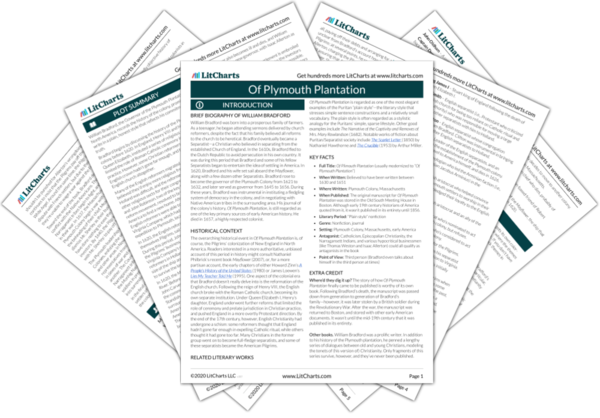Summary
Analysis
William Bradford says that he will begin with an account of the events that led to the foundation of the New Plymouth Settlement. He will tell this story in a “plain style,” telling the truth to the best of his mortal abilities.
Bradford promises to write in a simple, “plain” style, without lots of elaborate literary devices or sentence constructions. As a result, Of Plymouth Plantation is fairly easy for 21st century people to read, at least compared with other texts from the 1600s. Bradford characterizes the plain style as an extension of the Pilgrim ethos: simple, spare, and honest.
Themes
Literary Devices
Throughout history, Bradford claims, the Devil has tried to fight Christianity through various means. In ancient Rome, for example, he killed Christians. Then, when the Christian Church became powerful, he succeeded in tempting clergymen, so that Christianity itself was corrupted with “vile canons and decrees.” The Devil has used two different means to fight Christianity: attacking Christianity from the outside, and corrupting and twisting it from the inside. In modern England, the Devil has more often used the second method.
Bradford situates the story of the Pilgrims’ migration to America within a broader narrative, alluding to the persecution of Christians throughout history. Note, though, that he is careful to distinguish “true Christians” from “vile” Catholic institutions and ceremonies—and the true Christians are always portrayed as innocent victims of both supernatural and human evil.
Themes
Literary Devices
The Protestant reformers who sought to fight the evils of “popery” (Catholicism) became locked in a “bitter war” with each other. Virtuous Protestant reformers supported a simple Christian religion, based on humble pastors’ interpretations of the gospels. The other, “episcopal” reformers supported a Christianity tarnished by the “popish manner,” with its emphasis on gaudy ceremony. Under the reign of Queen Elizabeth, the episcopal party” became too powerful. They criticized other Christian reformers for being too “high and mighty,” and gave them a derisive nickname, “Puritans.” By emphasizing ceremony, episcopal Christians risked reverting to old-fashioned popery.
Bradford suggests that, even within the Protestant Reformation movement, some reformers didn’t go far enough in their desire to promote simplicity and spirituality. In the early 17th century, England had broken with the Catholic Church and founded its own version of Christianity, Anglicanism. There were many Protestant reformers, including Bradford himself, who criticized Anglicanism for being too similar to Catholicism (or “popery,” which Bradford assumes to be evil); first because it emphasized church hierarchy (the prelates), and second because it emphasized ceremony. Notice that Bradford doesn’t use the word Puritan to describe his followers, even though that’s the word most people use today—as with many other terms describing a group (“Yankee,” “Impressionist”), the insult has become the accepted term.
Themes
Literary Devices
The story of the Plymouth Plantation begins when a group of North English preachers found the true word of God. They began to reform their lives, despite the fact that they were scorned by their neighbors, and they refuse to acknowledge the authority of prelates (i.e., bishops and other high religious authorities). After the coronation of King James I, prelates begin to wield much more power over the English church, and the North English reformers saw that England was in danger of returning to popery.
The English reformers were scorned and persecuted in their own country at a time when religious freedom wasn’t seen as a fundamental right in England. These reformers were committed to simplifying the Christian church, getting rid of the complex hierarchies of bishops, ministers, and cardinals (although, to be clear, Puritans didn’t reject the concept of authority altogether—there were certainly Puritan reverends).
Themes
Get the entire Of Plymouth Plantation LitChart as a printable PDF.

One of the key leaders of the Northern English reformers is a man named John Smith. Another is a man named Richard Clifton—Clifton ends up playing the more significant role in the growth of the Plymouth Plantation. Clifton tries to institute reform in England, but eventually proposes that all Christian reformers should migrate to the Low Countries (i.e., present-day Netherlands and Belgium), where there’s supposedly more religious freedom. By 1608, there is a significant English population in Holland.
Historians have studied the reformers’ migration to Holland—at the time, Northern English people were unusually familiar with moving to a new community. This would suggest that, at least compared with most other Europeans of the time, North English reformers were especially willing to uproot their families and migrate to the Low countries. The move to Holland was something of a “trial run” for the longer, more challenging voyage to America.
Themes
Literary Devices












